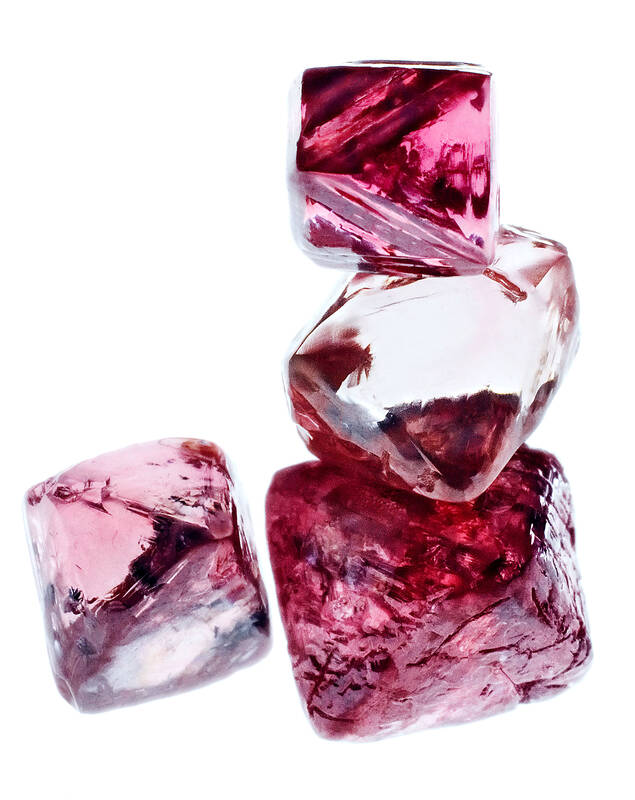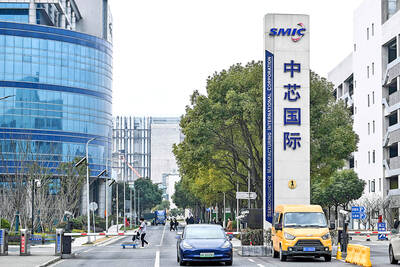Scientists said they have found the “missing ingredient” for pink diamonds, some of the world’s most expensive stones due their rarity and beauty, and the discovery could help find more.
More than 90 percent of all the pink diamonds ever found were discovered at the recently closed Argyle mine in the remote north of Western Australia.
Yet exactly why Argyle — which unlike most other diamond mines does not sit in the middle of a continent, but on the edge of one — produced so many pink gems has remained a mystery.

Photo: AFP / Nature Publishing Group / Traffic Studio #B
In a new study published in the journal Nature Communications, a team of Australia-based researchers said the pink diamonds were brought to the Earth’s surface by the break-up of the first supercontinent about 1.3 billion years ago.
Hugo Olierook, a research fellow at Curtin University in the state of Western Australia and the study’s lead author, on Tuesday said that two of the three ingredients for forming pink diamonds had already been known.
The first ingredient is carbon — and it must be in the bowels of Earth.
Anything shallower than 150km deep would be graphite — “that stuff in your pencils, not nearly as pretty on an engagement ring,” Olierook said.
The second ingredient is just the right amount of pressure, to damage the otherwise clear diamonds.
“Push just a little bit and it turns pink. Push a little too hard and they turn brown,” he said.
Most of the diamonds discovered at Argyle were of the less valuable brown hue, he added.
The missing ingredient was the volcanic event that sent the diamonds shooting up to the Earth’s surface, where humans could get their hands on them.
In the 1980s it was estimated that the Argyle diamonds emerged 1.2 billion years ago, but there was no “trigger” for the rare diamonds to rise at that time, Olierook said, so the researchers sought to establish a more accurate time line.
They used a laser thinner than a human hair to probe tiny crystals in an Argyle rock sample supplied by the mine’s owner, Anglo-Australian mining giant Rio Tinto Group.
By measuring the age of elements in the crystals, the researchers determined that Argyle was 1.3 billion years old — meaning the diamonds came up 100 million years later than previously thought.
That lines up with the breakup of the world’s first supercontinent, known as Nuna or Columbia.
In Nuna, “just about every single landmass on Earth was squashed together,” Olierook said.
The immense pressure that twisted color into the diamonds — the second ingredient — occurred during collisions between western Australia and northern Australia 1.8 billion years ago.
When Nuna started to break up 500 million years later, it reaggravated the “scar” from that event, Olierook said.
Magma shot up through this old scar “like a champagne cork going off,” taking the diamonds along for the ride, he said.
Study coauthor Luc Doucet said that such a “massive explosion” — which sent the diamonds traveling at near the speed of sound — has not taken place in recorded human history.
Over the past 200 years, people have mostly looked for diamonds in the center of massive continents.
However, knowing the “missing ingredient” for pink diamonds could assist future efforts to find the rare stones, Olierook said, adding that discovering more was unlikely to be easy or quick.
Old mountain belts marking Nuna’s breakup near the edges of continents have the potential to be home to a new “pink diamond paradise,” he said, naming Canada, Russia, southern Africa and Australia as possible locations.
John Foden, a professor and expert on diamonds at the University of Adelaide not involved in the study, said that the researchers had “convincingly shown” the age of the Argyle diamonds.
However, he said that other diamond-rich provinces had also been linked to Nuna’s breakup — and they had not produced pink diamonds.
This suggests that “pinkness seems to be a local Argyle attribute,” he said.
The Argyle mine closed in 2020 due to “various financial reasons,” Olierook said, meaning the value of pink diamonds could continue to rise as supply stalls.

NO BREAKTHROUGH? More substantial ‘deliverables,’ such as tariff reductions, would likely be saved for a meeting between Trump and Xi later this year, a trade expert said China launched two probes targeting the US semiconductor sector on Saturday ahead of talks between the two nations in Spain this week on trade, national security and the ownership of social media platform TikTok. China’s Ministry of Commerce announced an anti-dumping investigation into certain analog integrated circuits (ICs) imported from the US. The investigation is to target some commodity interface ICs and gate driver ICs, which are commonly made by US companies such as Texas Instruments Inc and ON Semiconductor Corp. The ministry also announced an anti-discrimination probe into US measures against China’s chip sector. US measures such as export curbs and tariffs

The US on Friday penalized two Chinese firms that acquired US chipmaking equipment for China’s top chipmaker, Semiconductor Manufacturing International Corp (SMIC, 中芯國際), including them among 32 entities that were added to the US Department of Commerce’s restricted trade list, a US government posting showed. Twenty-three of the 32 are in China. GMC Semiconductor Technology (Wuxi) Co (吉姆西半導體科技) and Jicun Semiconductor Technology (Shanghai) Co (吉存半導體科技) were placed on the list, formally known as the Entity List, for acquiring equipment for SMIC Northern Integrated Circuit Manufacturing (Beijing) Corp (中芯北方積體電路) and Semiconductor Manufacturing International (Beijing) Corp (中芯北京), the US Federal Register posting said. The

India’s ban of online money-based games could drive addicts to unregulated apps and offshore platforms that pose new financial and social risks, fantasy-sports gaming experts say. Indian Prime Minister Narendra Modi’s government banned real-money online games late last month, citing financial losses and addiction, leading to a shutdown of many apps offering paid fantasy cricket, rummy and poker games. “Many will move to offshore platforms, because of the addictive nature — they will find alternate means to get that dopamine hit,” said Viren Hemrajani, a Mumbai-based fantasy cricket analyst. “It [also] leads to fraud and scams, because everything is now

MORTGAGE WORRIES: About 34% of respondents to a survey said they would approach multiple lenders to pay for a home, while 29.2% said they would ask family for help New housing projects in Taiwan’s six special municipalities, as well as Hsinchu city and county, are projected to total NT$710.65 billion (US$23.61 billion) in the upcoming fall sales season, a record 30 percent decrease from a year earlier, as tighter mortgage rules prompt developers to pull back, property listing platform 591.com (591新建案) said yesterday. The number of projects has also fallen to 312, a more than 20 percent decrease year-on-year, underscoring weakening sentiment and momentum amid lingering policy and financing headwinds. New Taipei City and Taoyuan bucked the downturn in project value, while Taipei, Hsinchu city and county, Taichung, Tainan and Kaohsiung